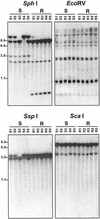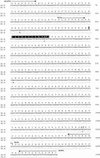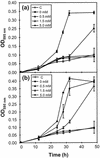Glyphosate-resistant goosegrass. Identification of a mutation in the target enzyme 5-enolpyruvylshikimate-3-phosphate synthase
- PMID: 12114580
- PMCID: PMC166520
- DOI: 10.1104/pp.001560
Glyphosate-resistant goosegrass. Identification of a mutation in the target enzyme 5-enolpyruvylshikimate-3-phosphate synthase
Abstract
The spontaneous occurrence of resistance to the herbicide glyphosate in weed species has been an extremely infrequent event, despite over 20 years of extensive use. Recently, a glyphosate-resistant biotype of goosegrass (Eleusine indica) was identified in Malaysia exhibiting an LD(50) value approximately 2- to 4-fold greater than the sensitive biotype collected from the same region. A comparison of the inhibition of 5-enolpyruvylshikimate-3-phosphate synthase (EPSPS) activity by glyphosate in extracts prepared from the resistant (R) and sensitive (S) biotypes revealed an approximately 5-fold higher IC(50)(glyphosate) for the (R) biotype. Sequence comparisons of the predicted EPSPS mature protein coding regions from both biotypes revealed four single-nucleotide differences, two of which result in amino acid changes. One of these changes, a proline to serine substitution at position 106 in the (R) biotype, corresponds to a substitution previously identified in a glyphosate-insensitive EPSPS enzyme from Salmonella typhimurium. Kinetic data generated for the recombinant enzymes suggests that the second substitution identified in the (R) EPSPS does not contribute significantly to its reduced glyphosate sensitivity. Escherichia coli aroA- (EPSPS deficient) strains expressing the mature EPSPS enzyme from the (R) biotype exhibited an approximately 3-fold increase in glyphosate tolerance relative to strains expressing the mature EPSPS from the (S) biotype. These results provide the first evidence for an altered EPSPS enzyme as an underlying component of evolved glyphosate resistance in any plant species.
Figures






Similar articles
-
A T42M substitution in bacterial 5-enolpyruvylshikimate-3-phosphate synthase (EPSPS) generates enzymes with increased resistance to glyphosate.Biosci Biotechnol Biochem. 2003 Jun;67(6):1405-9. doi: 10.1271/bbb.67.1405. Biosci Biotechnol Biochem. 2003. PMID: 12843673
-
Mutations and amplification of EPSPS gene confer resistance to glyphosate in goosegrass (Eleusine indica).Planta. 2015 Oct;242(4):859-68. doi: 10.1007/s00425-015-2324-2. Epub 2015 May 22. Planta. 2015. PMID: 25998526
-
Pro-106-Ser mutation and EPSPS overexpression acting together simultaneously in glyphosate-resistant goosegrass (Eleusine indica).Sci Rep. 2017 Jul 27;7(1):6702. doi: 10.1038/s41598-017-06772-1. Sci Rep. 2017. PMID: 28751654 Free PMC article.
-
Glyphosate Resistance and EPSPS Gene Duplication: Convergent Evolution in Multiple Plant Species.J Hered. 2018 Feb 14;109(2):117-125. doi: 10.1093/jhered/esx087. J Hered. 2018. PMID: 29040588 Review.
-
Expression of CP4 EPSPS in microspores and tapetum cells of cotton (Gossypium hirsutum) is critical for male reproductive development in response to late-stage glyphosate applications.Plant Biotechnol J. 2006 Sep;4(5):477-87. doi: 10.1111/j.1467-7652.2006.00203.x. Plant Biotechnol J. 2006. PMID: 17309724 Review.
Cited by
-
Target-Site Mutations Conferring Herbicide Resistance.Plants (Basel). 2019 Sep 28;8(10):382. doi: 10.3390/plants8100382. Plants (Basel). 2019. PMID: 31569336 Free PMC article. Review.
-
The P450 gene CYP749A16 is required for tolerance to the sulfonylurea herbicide trifloxysulfuron sodium in cotton (Gossypium hirsutum L.).BMC Plant Biol. 2018 Sep 10;18(1):186. doi: 10.1186/s12870-018-1414-2. BMC Plant Biol. 2018. PMID: 30200872 Free PMC article.
-
The First Case of Glyphosate Resistance in Johnsongrass (Sorghum halepense (L.) Pers.) in Europe.Plants (Basel). 2020 Mar 3;9(3):313. doi: 10.3390/plants9030313. Plants (Basel). 2020. PMID: 32138144 Free PMC article.
-
Physical Mapping of Amplified Copies of the 5-Enolpyruvylshikimate-3-Phosphate Synthase Gene in Glyphosate-Resistant Amaranthus tuberculatus.Plant Physiol. 2017 Feb;173(2):1226-1234. doi: 10.1104/pp.16.01427. Epub 2016 Dec 12. Plant Physiol. 2017. PMID: 27956489 Free PMC article.
-
Molecular Basis for Resistance Against Phosphonate Antibiotics and Herbicides.Medchemcomm. 2016 Jan 1;7(1):28-36. doi: 10.1039/C5MD00351B. Epub 2015 Oct 12. Medchemcomm. 2016. PMID: 26811741 Free PMC article.
References
-
- Baerson SR, Tran M, Rodriguez DJ, Gonzalez KA, Schafer DE, Krupa DM, Gruys KJ, Stalker DM, Taylor NA, Dill GM. Proceedings, 10th International Conference on Arabidopsis Research. Melrose Park, Australia: Manning Printers PTY LTD; 1999. Comparison of frequencies of individuals resistant to imazethapyr, chlorsulfuron, and glyphosate in EMS-mutagenized populations of Arabidopsis thaliana (cv. Col-0) pp. 5–7.
-
- Benbrook C. Racing against the clock. Agrichem Age. 1991;35:30–33.
-
- Boocock MR, Coggins JR. Kinetics of 5-enolpyruvylshikimate-3-phosphate synthase inhibition by glyphosate. FEBS Lett. 1983;154:127–133. - PubMed
-
- Bradford MM. A rapid and sensitive method for the quantitation of microgram quantities of protein utilizing the principle of protein-dye binding. Anal Biochem. 1976;72:248–254. - PubMed
-
- Bradshaw LD, Padgette SR, Kimball SL, Wells BH. Perspectives on glyphosate resistance. Weed Technol. 1997;11:189–198.
Publication types
MeSH terms
Substances
Associated data
- Actions
- Actions
LinkOut - more resources
Full Text Sources
Other Literature Sources
Research Materials

